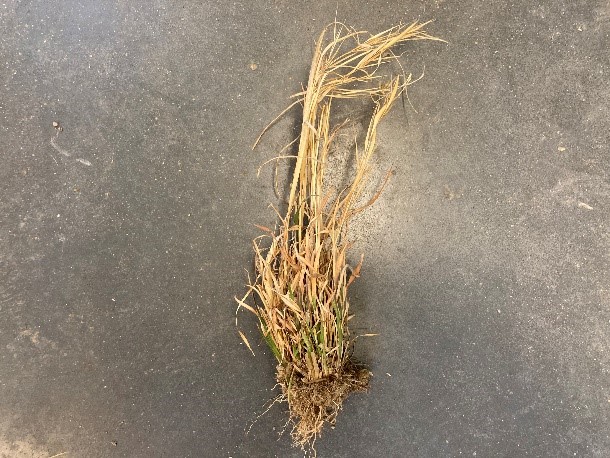In the past two weeks, I had two inquiries about a grass that was invading a grass hayfield and pasture. The pictures shared showed old growth of 2021 that was beige-bronze in color, narrow leaved, and had tufts of pubescence remaining. Most seed had been windblown during the fall and winter. The plant was the warm-season perennial bunchgrass broomsedge bluestem (Andropogan virginicus). Many have also likely asked “What is that plant” the past couple of months.
One of my first Purdue Extension in-field education events in the early 1980’s was my introduction to broomsedge bluestem. Areas of the southern Indiana grass pasture had more broomsedge bluestem than the desired forages that were seeded. I recall that a farmer leaned over and said “We call it poverty weed”. I once thought that broomsedge bluestem was a southern Indiana plant only, but as the years have gone by I see the plant all over Indiana. A few years ago, a group of farmers were doing sensory analyses of different hay samples and chemical analyses were available, too. One of the samples on display, was broomsedge bluestem. The chemical forage analysis verified why the grass has the nickname poverty weed. It would have made better bedding than a feed resource.
Broomsedge bluestem is a biological indicator plant. Where it becomes invasive it is common that the soil pH and/or phosphorus are very low. The method of reducing broomsedge bluestem is not investing in an herbicide application, but to apply the recommended amount of limestone or fertilizer as determined by a soil test. Slow but sure, the desired forages will become more dominant.
As hay is harvested, nutrients are being removed. In time, deficiencies will occur if nutrients are not wisely replaced by commercial fertilizer or livestock manure applications. Don’t let your field go into poverty status!
Resource information:
BROOMSEDGE BLUESTEM Plant Fact Sheet (usda.gov)
Photo contributed by Keith Johnson, Purdue University Extension Forage Specialist



